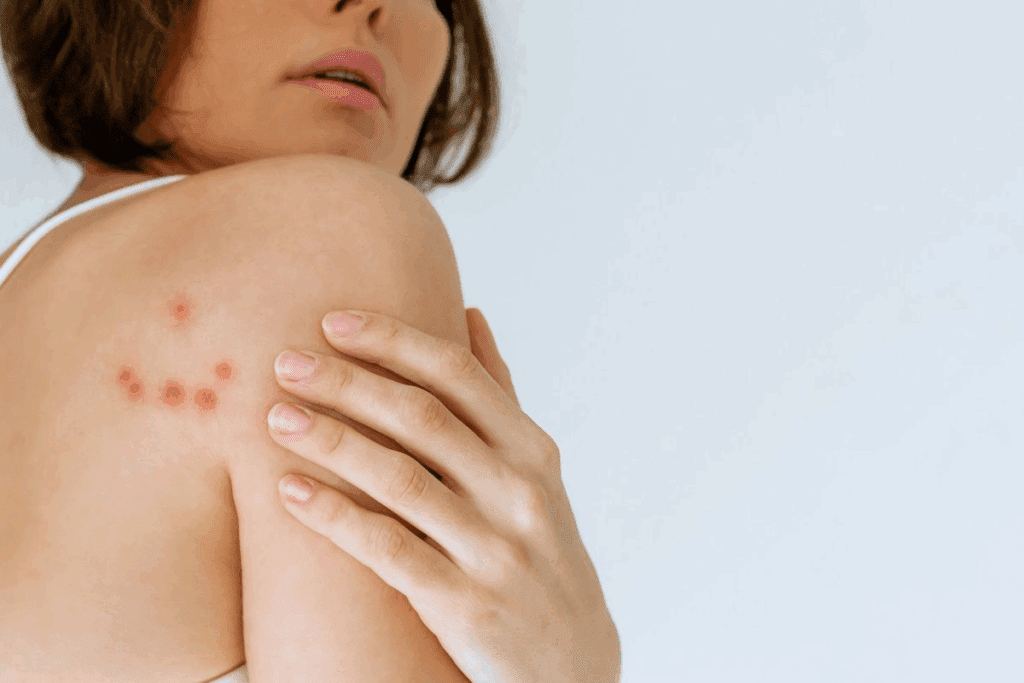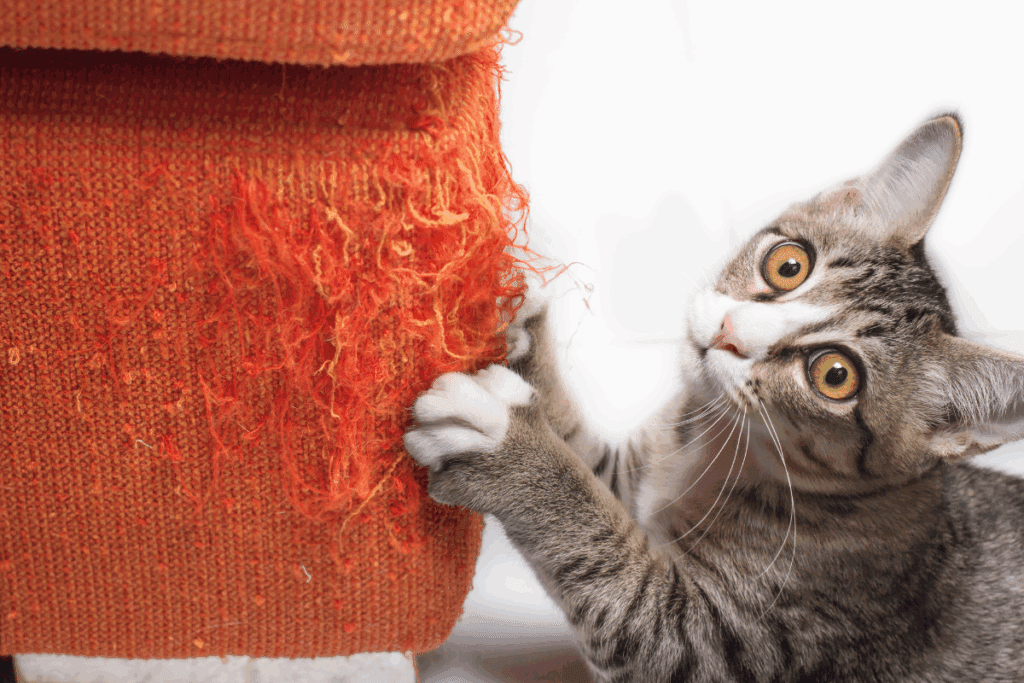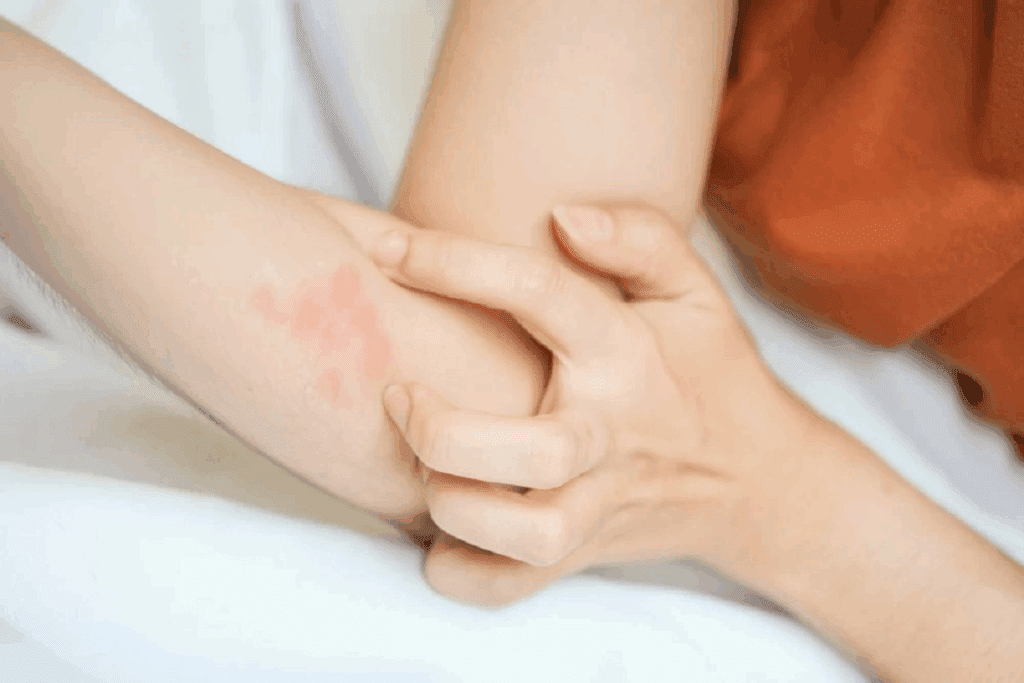Last Updated on November 20, 2025 by Ugurkan Demir

Seeing tiny red or purple spots on your skin after scratching can be scary. At Liv Hospital, we know how worried you must be. We focus on finding and fixing the problem.
Petechiae are small, pinpoint spots caused by minor bleeding under the skin, typically measuring less than 2 millimeters. Excessive or repeated scratching can cause petechiae from scratching. This happens when the trauma breaks tiny blood vessels close to the skin surface.
It’s important to understand how scratching can lead to petechiae. This helps us find the cause and get the right medical help. We aim to give top-notch care to patients from around the world.

Petechiae are small spots on the skin, inside the mouth, or on eyelids. They can be red, purple, or brown. These spots are common and can be caused by many things, like scratching.
Petechiae are tiny, usually under 2 mm in size, and flat. They don’t change color when pressed. You can find them alone or in groups on different parts of the body.
Key characteristics of petechiae include:
Petechiae are often mixed up with purpura and ecchymosis. But they are different. Purpura and ecchymosis are bigger and caused by different things.
It’s important to know the difference for the right treatment.
| Condition | Size | Characteristics |
| Petechiae | Less than 2 mm | Small, flat, non-blanching spots |
| Purpura | Larger than 2 mm | Larger patches of bleeding under the skin |
| Ecchymosis | Variable, often larger | Larger bruises |
In summary, petechiae are small, flat spots on the skin. They are different from other skin conditions. Knowing this helps in identifying and treating petechiae.

Scratching can lead to petechiae by damaging small blood vessels in the skin. This happens when we apply force to the skin while scratching.
People with sensitive skin or certain conditions are more likely to get petechiae from scratching. Research shows that petechiae can be caused by many things, like straining, infections, and some medicines.
Scratching can cause small blood vessels to break. This is because of the force applied during scratching. When these vessels break, blood leaks into the skin, creating the small, red or purple spots seen in petechiae.
Petechiae can show up in different parts of the body, depending on where you scratch. Common spots include the arms, legs, and back. These areas are often itchy and prone to scratching.
| Area of Body | Common Causes of Itching | Likelihood of Petechiae |
| Arms | Dry skin, eczema | High |
| Legs | Insect bites, dry skin | High |
| Back | Eczema, allergic reactions | Moderate |
Knowing how scratching can lead to petechiae is important, mainly if you have sensitive skin. Try to resist scratching and take good care of your skin to lower the chance of getting petechiae.
Petechiae from scratching show broken capillaries, a concern on sensitive skin like the face. Scratching can damage tiny blood vessels under the skin, causing small spots.
The risk is higher on sensitive skin, like the face, after strong emotions like crying. Knowing how to spot these spots is key to understanding their cause.
Scratching-induced petechiae look like small, red or purple dots on the skin. They are flat and their color changes with age and skin tone.
Key characteristics include:
These signs help identify petechiae from scratching. But, it’s important to know the difference from other causes.
To tell scratching-induced petechiae from others, observe carefully. Other causes include medical issues like leukemia or blood disorders.
| Cause | Characteristics | Common Locations |
| Scratching | Small, red/purple, flat | Areas subjected to scratching |
| Medical Conditions (e.g., Leukemia) | Varying size, may be widespread | Can appear anywhere on the body |
| Physical Trauma | May be larger, irregular shape | Areas subjected to trauma |
The table shows how to tell petechiae apart by their look and where they are. If they appear without reason or everywhere, it might mean a medical issue.
It’s important to watch our skin and see a doctor for unusual petechiae. Knowing about petechiae helps us take care of our skin.
Knowing the risk factors for petechiae when scratching is key to prevention and treatment. At Liv Hospital, we focus on quality care and educating our patients. This helps them manage their conditions well.
Some health conditions and medications raise the risk of petechiae. We’ll dive into these factors to help you lower your risk.
Skin sensitivity is a big factor in petechiae from scratching. People with skin conditions like eczema or dermatitis are more likely to get petechiae. This is because their skin is more sensitive and they tend to scratch harder.
Doctors say that “Skin that’s more sensitive or damaged is more likely to get petechiae from scratching. This is because the blood vessels near the skin’s surface are weaker.”
“The skin’s natural barrier function is compromised in conditions like eczema, making it more susceptible to damage from scratching.”
Underlying health conditions can greatly affect the risk of petechiae. Conditions that affect blood clotting or vessel integrity, like leukemia or vasculitis, raise the risk of petechiae.
These conditions make it hard for the body to keep blood vessels healthy. This makes them more likely to get damaged from scratching.
Some medications can also up the risk of petechiae. Anticoagulant medications, for example, can affect blood clotting. This makes it easier for petechiae to form.
It’s important for patients to tell their healthcare providers about any medications they’re taking. This helps assess their risk factors accurately.
By understanding these risk factors, we can better manage and prevent petechiae from scratching. At Liv Hospital, we stress the importance of complete care. This includes educating patients on managing their risk factors.
Petechiae can come from many kinds of physical trauma, not just scratching. These small spots on the skin can appear from different injuries.
Trauma-induced petechiae happen when small blood vessels under the skin burst. This can be due to many reasons, not just scratching. Knowing what causes petechiae is key for treating them.
Many types of physical trauma can lead to petechiae. These include:
A study found that intense coughing or vomiting can cause spots around the eyes or face. This is because of increased pressure in the veins.
Different traumas can lead to different kinds of petechiae. For example, infections might cause petechiae with fever and other symptoms. Physical injuries might only show spots in the injured area.
| Type of Trauma | Characteristics of Petechiae | Associated Symptoms |
| Physical Injury | Localized to the area of injury | Pain, swelling |
| Infections | Widespread, possibly accompanied by purpura | Fever, malaise |
| Prolonged Pressure | Localized to areas under pressure | Skin irritation, possible ulceration |
Doctors say that most petechiae from trauma are not serious and go away once the cause is fixed. But, if petechiae spread or don’t go away, it’s important to see a doctor.
In summary, petechiae trauma includes many causes, not just scratching. It’s important to understand these causes for proper treatment.
Intense crying can cause red dots around the eyes. This is due to a condition called petechiae. These are small spots on the skin from minor bleeding in broken capillaries.
Crying, and intense crying in particular, can put pressure on blood vessels around the eyes. This pressure can make the tiny capillaries in this area break. This leads to petechiae.
People with sensitive skin or health issues are more at risk. Factors that contribute to getting periorbital petechiae after crying include:
| Factor | Description | Impact on Petechiae Development |
| Increased Venous Pressure | Raised pressure in veins due to straining or intense crying | High |
| Delicate Skin | Sensitive skin around the eyes | Moderate to High |
| Underlying Vascular Conditions | Pre-existing conditions affecting blood vessels | Variable |
While you can’t always prevent petechiae, there are ways to reduce their chance after crying. Gentle skin care and avoiding harsh rubbing can help. Cold compresses can also reduce the risk. For more tips, visit Proven Skincare.
To manage and prevent crying-induced petechiae, try these strategies:
Understanding the causes and taking proactive steps can help reduce red dots around the eyes.
Knowing when petechiae are serious is key for quick medical help. At Liv Hospital, we aim to give top-notch care and teach our patients about warning signs. This helps us catch problems early.
Petechiae can show up in different ways. It’s important to tell the normal from the concerning ones. Small, few, and fading in a few days are usually okay. But, if they grow or don’t go away, it might mean something’s wrong.
Watch where petechiae appear too. Seeing them on many parts of the body, with fever or tiredness, could mean a big issue. Doctors say petechiae can signal serious problems like leukemia.
Some signs need you to see a doctor fast, even with petechiae. These include:
If you have these symptoms with petechiae, get help right away. At Liv Hospital, we’re all about top healthcare and support for international patients.
“Early detection and treatment can significantly improve outcomes for patients with conditions associated with petechiae.”
In short, while petechiae can be harmless, knowing the serious signs is key. If you’re not sure or have other symptoms, see a doctor. It’s always better to be safe than sorry.
Petechiae can be scary, and finding out why they appear is important. It’s key to understand how scratching might cause them. This helps us find the main reason.
We start by looking closely at the petechiae. We check their size, color, and where they are on the body. We also look at the patient’s past health to see if anything might be causing them.
Knowing the patient’s medical history is very important. It helps us see if there are any risks, like recent illnesses or injuries. We also ask about family history to see if there might be a genetic link.
After the first check, we might need to do more tests. These tests help us find out why the petechiae are there. Some tests we might do include:
| Test | Purpose |
| Complete Blood Count (CBC) | To check for any problems with blood cells that could mean a bleeding issue or infection. |
| Blood Chemistry Tests | To see how well the liver and kidneys are working, as problems here can cause petechiae. |
| Coagulation Studies | To see if the blood can clot right, which helps find out if there’s a clotting problem. |
| Imaging Studies (e.g., X-rays, CT scans) | To look for any internal injuries or diseases that might be causing the petechiae. |
Finding out why petechiae appear, like from scratching or other injuries, needs a careful plan. We use what we learn from the check-ups and tests to figure out the cause. Then, we can start the right treatment.
Petechiae from scratching can be treated in many ways. These range from simple home remedies to more serious medical treatments. At Liv Hospital, we focus on treating the cause of the problem.
For mild petechiae, simple steps can help. Keeping the skin moisturized is key. We suggest using gentle, fragrance-free moisturizers to calm the skin.
Also, avoiding harsh soaps and extreme temperatures helps prevent more irritation.
Here are some useful tips:
“The key to managing petechiae is understanding that it’s not just a skin issue, but often a sign of an underlying condition that needs attention.”
When petechiae are severe or don’t go away, medical help is needed. The treatment depends on the cause. We might suggest topical corticosteroids to reduce swelling or antihistamines to stop itching.
For serious cases, we do more tests to find the cause. At Liv Hospital, we offer detailed care. This includes tests to find the cause and the right treatment plan.
To stop petechiae from scratching, we need to tackle it from all sides. This means managing the urge to scratch and taking good care of our skin. By knowing why it happens and using the right strategies, we can cut down on petechiae a lot.
It’s key to control the urge to scratch to avoid petechiae. Here are some ways to do it:
If you have skin conditions like eczema, it’s vital to manage them. This might mean using special medicines or treatments to lower inflammation and itchiness.
Good skin care can lower the chance of getting petechiae from scratching. Here are some tips:
| Skin Care Practice | Benefit |
| Moisturizing regularly | Reduces dryness and itchiness |
| Avoiding hot showers | Prevents stripping the skin of its natural oils |
| Using gentle skin products | Minimizes irritation and itchiness |
Changing your environment can also help prevent petechiae. Here’s how:
By using these methods, you can lower your risk of getting petechiae from scratching. It’s also good to know about “petekia” and “peticia,” which are other names for petechiae in different situations.
Petechiae are known by many names in medicine and languages. Healthcare workers often see different terms for the same thing. It’s key to know these names to talk clearly and make the right diagnosis.
Worldwide, petechiae have many names. For example, “petekia,” “petecchie,” “petequia,” and “petiquias” are used in various languages. These terms all point to small spots on the skin.
| Language | Term Used for Petechiae |
| Spanish | Petiquias |
| Italian | Petechie |
| Other variations | Petekia, Petequia |
The word “petechiae” is often misspelled. People might say “petechiae plural” as if it’s one thing. Spelling changes happen because of language differences. Knowing these helps us understand and treat patients better.
When we read medical texts or talk to patients, knowing these names is important. It helps us give better care and be more understanding.
Understanding petechiae and their causes is key to getting the right medical help. We’ve looked at how scratching can lead to petechiae and how to avoid it. This includes the risks and prevention methods.
Scratching can cause broken capillaries, leading to petechiae. It’s important to know that petechiae might show an underlying health issue. So, if you’re worried about petechiae from scratching, you should get it checked.
At Liv Hospital, we focus on top-notch care for international patients. Our team is ready to offer world-class healthcare and support.
To lower your risk of petechiae, learn about its causes and how to prevent it. If you’re worried about petechiae or other skin issues, don’t hesitate to see a doctor.
Petechiae are small, pinpoint spots on the skin from bleeding capillaries. They are usually red or purple. Various factors, like scratching or trauma, can cause them.
Yes, scratching can lead to petechiae, mainly if the skin is sensitive. Vigorous scratching can damage capillaries, causing these spots.
Petechiae from scratching often appear in irritated areas. They might be red or inflamed. A doctor can help figure out the cause.
Risk factors include sensitive skin and health issues affecting blood clotting. Certain medications can also play a role.
Yes, crying can lead to petechiae around the eyes. This is due to increased pressure and friction on the skin. It’s usually harmless.
Be concerned if petechiae are numerous, widespread, or with fever, fatigue, or other bleeding. Also, worry if they appear without a clear cause.
Diagnosing petechiae involves a medical check-up, including a physical exam and medical history. Lab tests might be needed to find underlying conditions.
Treatments include avoiding scratching, moisturizing the skin, and using cold compresses. Medical treatments might be needed for underlying conditions.
Prevent petechiae by managing scratching urges and practicing good skin care. Use gentle products and wear protective clothing.
Common misspellings include petekia, petecchie, petequia, and petiquias. Knowing these can help in searching and talking to doctors.
The plural form of petechia is petechiae.
National Health Service. (2023, November 28). Rash. nhs.uk. https://www.nhs.uk/conditions/rash/
Sandroni, A. M., & Glesinger, A. (2024). Petechiae. In StatPearls. StatPearls Publishing. https://www.ncbi.nlm.nih.gov/books/NBK560633/
Subscribe to our e-newsletter to stay informed about the latest innovations in the world of health and exclusive offers!